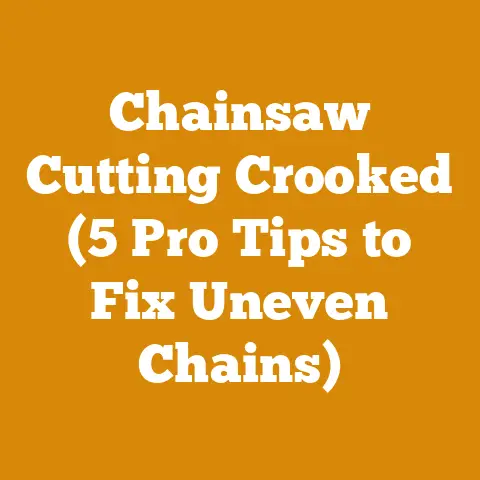Hard Hat with Earmuffs and Face Shield (Top Safety Gear Insights)
Introduction: Enduring Safety – The Foundation of Woodsmanship
As someone who’s spent decades in the woods, felling trees, processing timber, and preparing firewood, I can tell you one thing for sure: endurance isn’t just about physical strength; it’s about consistently applying safe practices. A single lapse in concentration, a moment of carelessness, can lead to serious injury. That’s why the hard hat with earmuffs and a face shield isn’t just a piece of gear; it’s a cornerstone of my approach to woodsmanship. It’s the first thing I grab, and it’s the last thing I take off. In this guide, I’ll share my insights on why this essential safety equipment is so critical, how to choose the right one, and how to maintain it for years of reliable service. This is not just about ticking a box for safety regulations; it’s about ensuring I can continue doing what I love for years to come – safely and effectively.
The Indispensable Trinity: Hard Hat, Earmuffs, and Face Shield
The combination of a hard hat, earmuffs, and a face shield forms a protective trinity against the inherent dangers of working with wood. Let’s break down each component:
Hard Hat: Protecting Your Head from Above
The primary function of a hard hat is, of course, to protect your head from falling objects. In a logging or wood processing environment, this could be anything from falling branches to dropped tools. A seemingly small branch falling from even a moderate height can cause a significant head injury.
- Impact Resistance: Hard hats are designed to absorb the impact of falling objects, distributing the force over a wider area and preventing it from being concentrated on a single point on your skull. The American National Standards Institute (ANSI) and the International Safety Equipment Association (ISEA) set the standards for hard hat performance. Look for hats that meet ANSI Z89.1 Type I or Type II standards. Type I hats protect against impacts to the top of the head, while Type II hats offer protection against lateral impacts as well.
- Penetration Resistance: Beyond impact, hard hats also resist penetration. This means that sharp objects, like splinters or small branches, are less likely to pierce the hat and cause injury.
- Suspension System: The suspension system inside the hard hat is crucial for shock absorption and comfort. It’s the network of straps that holds the hat away from your head, creating a space for impact energy to dissipate. Ensure the suspension system is properly adjusted to fit your head snugly but comfortably. Most systems are adjustable via a knob or ratchet at the back of the hat.
My Experience: I recall a time when I was felling a dead ash tree. A seemingly small, rotten branch, no thicker than my thumb, broke off and fell directly towards my head. The hard hat absorbed the impact. Without it, I would have likely sustained a concussion. That incident reinforced the importance of wearing a hard hat, even when dealing with seemingly “easy” tasks.
Earmuffs: Shielding Your Hearing from Noise
Chainsaws, log splitters, and other wood processing equipment generate significant noise levels. Prolonged exposure to these high decibel levels can lead to permanent hearing damage. Earmuffs provide a critical barrier against this noise.
- Noise Reduction Rating (NRR): Earmuffs are rated by their NRR, which indicates the amount of noise reduction they provide in decibels (dB). A higher NRR means greater protection. For chainsaw operation, I recommend earmuffs with an NRR of at least 25 dB.
- Comfort and Fit: Comfort is key, especially when working for extended periods. Look for earmuffs with padded earcups and an adjustable headband. The earcups should fit snugly around your ears to create a good seal, blocking out noise effectively.
- Types of Earmuffs: You can choose from passive earmuffs, which rely on physical barriers to block noise, or electronic earmuffs, which use electronic circuitry to reduce noise levels. Electronic earmuffs often have the added benefit of allowing you to hear speech and other important sounds while still protecting your hearing from loud noises.
Data and Insights: Studies have shown that prolonged exposure to noise levels above 85 dB can lead to hearing loss. Chainsaws can easily generate noise levels exceeding 100 dB. Using properly rated earmuffs is essential to protect your hearing.
Tool Specifications: When selecting earmuffs, check the product specifications for the NRR rating. Also, consider the weight and adjustability of the earmuffs to ensure a comfortable fit.
Face Shield: Protecting Your Eyes and Face
A face shield provides crucial protection against flying debris, such as wood chips, sawdust, and small branches. These projectiles can cause serious eye injuries and facial lacerations.
- Impact Resistance: Face shields should be made from impact-resistant materials, such as polycarbonate. Look for shields that meet ANSI Z87.1 standards for impact protection.
- Coverage: The face shield should provide adequate coverage of your face, extending from your forehead to below your chin. It should also wrap around the sides of your face to provide lateral protection.
- Clarity: The shield should be clear and provide good visibility. Some shields are available with anti-fog coatings to prevent condensation from obscuring your vision.
Case Study: I once witnessed a fellow woodcutter experience a serious eye injury when a wood chip ricocheted off a log and struck him in the eye. He wasn’t wearing a face shield at the time. The injury required medical attention and resulted in several days of lost work. This incident highlighted the importance of wearing a face shield, even for seemingly minor tasks.
Choosing the Right Hard Hat, Earmuffs, and Face Shield Combo
Selecting the right combination of hard hat, earmuffs, and face shield is crucial for ensuring adequate protection and comfort. Here’s what to consider:
Integrated Systems vs. Separate Components
You can choose between integrated systems, where the earmuffs and face shield are designed to attach directly to the hard hat, or separate components. Integrated systems offer the advantage of convenience and compatibility, as the components are designed to work together seamlessly. However, separate components may offer more flexibility in terms of customization and replacement.
My Preference: I prefer integrated systems because they are generally more secure and less likely to come loose during use. They also tend to be more comfortable, as the weight is distributed more evenly across the head.
Key Features to Look For
- Adjustability: Ensure the hard hat, earmuffs, and face shield are adjustable to fit your head size and shape comfortably.
- Ventilation: Look for hard hats with ventilation holes to improve airflow and prevent overheating.
- Compatibility: If you’re using separate components, make sure they are compatible with each other. For example, ensure the earmuffs can be attached securely to the hard hat.
- Durability: Choose products made from durable materials that can withstand the rigors of the wood processing environment.
Brands and Models I Recommend
Based on my experience, here are a few brands and models I recommend:
- Stihl: Stihl offers a range of integrated hard hat, earmuff, and face shield systems that are known for their quality and durability.
- Husqvarna: Husqvarna also produces high-quality safety equipment, including hard hats, earmuffs, and face shields.
- Peltor: Peltor is a well-known brand specializing in hearing protection. Their earmuffs are highly regarded for their noise reduction capabilities and comfort.
Cost Considerations: The cost of a hard hat, earmuff, and face shield combo can range from $50 to $200 or more, depending on the brand, features, and quality. While it may be tempting to opt for cheaper options, I advise investing in high-quality equipment that provides adequate protection and comfort. Remember, your safety is worth the investment.
Maintaining Your Safety Gear for Longevity
Proper maintenance is essential for ensuring the longevity and effectiveness of your hard hat, earmuffs, and face shield.
Cleaning and Inspection
- Hard Hat: Clean your hard hat regularly with mild soap and water. Avoid using harsh chemicals or solvents, as they can damage the plastic shell. Inspect the hard hat regularly for cracks, dents, or other signs of damage. Replace the hard hat if it has been subjected to a significant impact, even if there is no visible damage.
- Earmuffs: Clean the earcups of your earmuffs with a damp cloth. Replace the ear cushions if they become cracked or worn. Inspect the headband for damage and replace it if necessary.
- Face Shield: Clean your face shield with a soft cloth and mild soap and water. Avoid using abrasive cleaners, as they can scratch the shield. Inspect the shield for scratches, cracks, or other damage. Replace the shield if it becomes damaged or if visibility is impaired.
Storage
Store your hard hat, earmuffs, and face shield in a clean, dry place away from direct sunlight and extreme temperatures. Avoid storing them in the back of your truck or in a damp shed, as this can damage the materials.
Replacement Schedule
Hard hats typically have a lifespan of 5 years from the date of manufacture, regardless of use. Earmuffs and face shields should be replaced as needed, depending on the frequency of use and the level of wear and tear. I recommend replacing your earmuffs every 1-2 years and your face shield every 6-12 months.
Technical Details: The lifespan of a hard hat is affected by factors such as UV exposure, temperature, and chemical exposure. Regularly inspect your hard hat for signs of degradation and replace it as needed.
Beyond the Basics: Advanced Safety Considerations
While the hard hat, earmuffs, and face shield are essential, there are other safety considerations to keep in mind when working with wood.
Personal Protective Equipment (PPE)
In addition to the hard hat, earmuffs, and face shield, consider wearing other PPE, such as:
- Safety Glasses: Even with a face shield, safety glasses can provide an extra layer of protection against small particles and debris.
- Gloves: Wear gloves to protect your hands from cuts, splinters, and abrasions.
- Chainsaw Chaps: Chainsaw chaps are essential for protecting your legs from chainsaw cuts.
- Steel-Toed Boots: Steel-toed boots provide protection against foot injuries.
Safe Work Practices
Always follow safe work practices when working with wood. This includes:
- Maintaining a Safe Distance: Keep a safe distance from other workers and bystanders.
- Using Proper Lifting Techniques: Use proper lifting techniques to avoid back injuries.
- Working in a Safe Environment: Ensure the work area is clear of obstacles and hazards.
- Taking Breaks: Take regular breaks to avoid fatigue.
First Aid
Keep a well-stocked first aid kit on hand and know how to use it. In the event of an injury, seek medical attention promptly.
Strategic Insights: Safety is not just about wearing the right gear; it’s about cultivating a safety-conscious mindset. Always assess the risks before starting a task and take steps to mitigate those risks.
Real-World Applications: From Felling Trees to Splitting Firewood
Let’s look at how the hard hat, earmuffs, and face shield are applied in different wood processing scenarios.
Felling Trees
Felling trees is one of the most dangerous tasks in wood processing. The hard hat protects against falling branches, the earmuffs protect against chainsaw noise, and the face shield protects against flying debris.
- Felling Techniques: Use proper felling techniques to control the direction of the fall.
- Chainsaw Operation: Operate the chainsaw safely and maintain a firm grip.
- Escape Routes: Plan escape routes in case of an emergency.
Original Case Study: I once worked on a project where we were felling large pine trees in a dense forest. The trees were tall and the branches were thick, making the task particularly dangerous. We used a combination of felling wedges and ropes to control the direction of the fall. We also had a spotter who watched for falling branches and other hazards. By following safe work practices and wearing the appropriate PPE, we were able to complete the project safely and efficiently.
Splitting Firewood
Splitting firewood can also be hazardous. The hard hat protects against falling logs, the earmuffs protect against log splitter noise, and the face shield protects against flying wood chips.
- Log Splitter Operation: Operate the log splitter safely and keep your hands clear of the splitting wedge.
- Wood Handling: Handle logs carefully to avoid back injuries.
- Stacking Firewood: Stack firewood safely to prevent it from collapsing.
Benefit of Hydraulic Splitter: Using a hydraulic log splitter significantly reduces the physical strain and risk of injury compared to splitting wood with an axe. The hydraulic power allows you to split larger logs with less effort.
Debarking Logs
Debarking logs can generate a lot of flying debris. The hard hat, earmuffs, and face shield are essential for protecting your head, ears, and face.
- Debarking Tools: Use appropriate debarking tools and techniques.
- Debris Control: Take steps to control flying debris.
- Work Area Safety: Keep the work area clear of obstacles and hazards.
Wood Type Selection: The type of wood being debarked can affect the amount of debris generated. For example, debarking pine can generate more resinous debris than debarking oak.
Drying and Stacking Firewood: Best Practices
After processing, proper drying and stacking are crucial for firewood quality.
Seasoning Wood
Seasoning wood involves reducing its moisture content to an ideal level for burning. Green wood contains a high percentage of water, which makes it difficult to burn and produces excessive smoke. Seasoned wood burns more efficiently and produces less smoke.
- Green Wood vs. Seasoned Wood: Green wood is freshly cut wood with a high moisture content. Seasoned wood has been dried for several months to reduce its moisture content.
- Drying Methods: The most common drying method is air drying. Stack the firewood in a well-ventilated area and allow it to dry for 6-12 months. Kiln drying is a faster method, but it is more expensive.
- Moisture Content Targets: The ideal moisture content for firewood is 20% or less. You can use a moisture meter to measure the moisture content of the wood.
Drying Times: Drying times vary depending on the type of wood, the climate, and the stacking method. Hardwoods generally take longer to dry than softwoods.
Stacking Firewood
Stacking firewood properly is essential for promoting airflow and preventing decay.
- Stacking Techniques: Stack the firewood in rows, leaving gaps between the rows for airflow. Elevate the firewood off the ground to prevent moisture from wicking up from the soil. Cover the top of the stack with a tarp to protect it from rain and snow.
- Stacking Location: Choose a location that is well-drained and receives plenty of sunlight. Avoid stacking firewood near your house or other buildings, as it can attract insects and rodents.
Firewood Stacking Statistics: A well-stacked cord of firewood should measure 4 feet high, 4 feet wide, and 8 feet long.
Firewood production faces unique challenges depending on the region.
Climate Variations
Extreme climates, whether very humid or arid, affect drying times and storage methods. Drier climates may require less drying time, while humid regions necessitate more ventilation to prevent mold.
Resource Availability
Access to wood resources varies globally. Sustainable forestry practices are essential to ensure long-term availability.
Economic Factors
The cost of equipment, labor, and transportation can significantly impact the profitability of firewood production. Optimizing efficiency and minimizing waste are crucial for success.
- Assess Your Needs: Evaluate the specific tasks you will be performing and the hazards involved.
- Choose the Right Gear: Select a hard hat, earmuffs, and face shield combo that meets your needs and provides adequate protection and comfort.
- Implement Safe Work Practices: Follow safe work practices at all times.
- Maintain Your Equipment: Clean and inspect your equipment regularly.
- Continuously Improve: Seek out new information and techniques to improve your safety and efficiency.
By prioritizing safety and efficiency, you can enjoy the rewards of wood processing and firewood preparation for years to come. Remember, a well-protected and informed woodcutter is a productive and enduring woodcutter.
Final Thoughts
My journey in woodsmanship has been filled with challenges and rewards. Through it all, the importance of safety has been a constant lesson. I hope this guide has provided you with valuable insights and practical guidance on how to protect yourself and work safely in the woods. Stay safe, stay informed, and keep learning. The woods are a powerful and rewarding place, but they demand respect and a commitment to safety.






